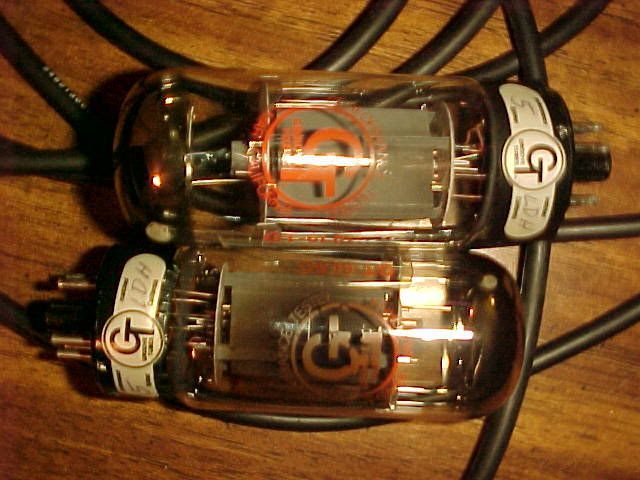The time has come. The beloved power tubes in my VT40 Ampeg are going south. Can't complain they are the original Ampeg labeled variety.
I have been considering suitable replacements for some time as I knew that power tube replacement, like death and taxes are inevitable.
I have researched the replacements; the 6L6 family of tubes (6L6, 7027, 5881, 7581A, KT66 etc.), EL34 family of tubes (EL34, KT77, 6CA7) and 6550 family of tubes (6550, KT88, KT90. Yikes, Ampeg certainly planned ahead.
I ruled out the EL34 due to changes needed to the circuit. I thought that would simplify things. Ha!
The 6550 family of tubes are a consideration and are the Ampeg recommended replacement but that would produce 80 watts and the current 60 watts is a handful and a loud one at that.
I haven't ruled 6550s out but my main focus is the 6L6 family of tubes the 7027A is part of i.e. NOS 7027As, NOS 7581As or new 6L6GCs from Winged C SED, JJ and Sovtek.
My main consideration is sound. Volume is less a consideration. Mostly it's the tone and smooth transitions from clean, to overdrive to distortion. I play everything from crystal, warm cleans, through bluesy overdrive to full on distortion all of which the VT40, in top shape, does well if you can get the volume up without making your ears bleed. I use a Marshall Power Brake (what irony) for this purpose and it is excellent.
Also, do I just plug them in and go or do I make changes to the circuit (bias etc.) to correct for wear / inherent weaknesses like the capacitors in the bias circuit, filter caps etc.?
Yikes what a pain. Pass the aspirin. But what an education. These forums are great for trading info.
My question, and I do have one, is this. But has anyone personally converted their V Series Ampeg (V2, VT40, V4, VT22) from NOS 7027As to current production 7027As, 6L6GCs or 6550s?
What brand did you use? Did you modify the bias circuit or make any other modifications? Did the change in power tubes result in other repairs having to be made. What was the end result?
I have been considering suitable replacements for some time as I knew that power tube replacement, like death and taxes are inevitable.
I have researched the replacements; the 6L6 family of tubes (6L6, 7027, 5881, 7581A, KT66 etc.), EL34 family of tubes (EL34, KT77, 6CA7) and 6550 family of tubes (6550, KT88, KT90. Yikes, Ampeg certainly planned ahead.
I ruled out the EL34 due to changes needed to the circuit. I thought that would simplify things. Ha!
The 6550 family of tubes are a consideration and are the Ampeg recommended replacement but that would produce 80 watts and the current 60 watts is a handful and a loud one at that.
I haven't ruled 6550s out but my main focus is the 6L6 family of tubes the 7027A is part of i.e. NOS 7027As, NOS 7581As or new 6L6GCs from Winged C SED, JJ and Sovtek.
My main consideration is sound. Volume is less a consideration. Mostly it's the tone and smooth transitions from clean, to overdrive to distortion. I play everything from crystal, warm cleans, through bluesy overdrive to full on distortion all of which the VT40, in top shape, does well if you can get the volume up without making your ears bleed. I use a Marshall Power Brake (what irony) for this purpose and it is excellent.
Also, do I just plug them in and go or do I make changes to the circuit (bias etc.) to correct for wear / inherent weaknesses like the capacitors in the bias circuit, filter caps etc.?
Yikes what a pain. Pass the aspirin. But what an education. These forums are great for trading info.
My question, and I do have one, is this. But has anyone personally converted their V Series Ampeg (V2, VT40, V4, VT22) from NOS 7027As to current production 7027As, 6L6GCs or 6550s?
What brand did you use? Did you modify the bias circuit or make any other modifications? Did the change in power tubes result in other repairs having to be made. What was the end result?

Comment